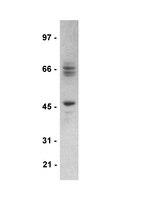A protein tyrosine phosphatase expressed within dopaminoceptive neurons of the basal ganglia and related structures.
Lombroso, P J, et al.
J. Neurosci., 13: 3064-74 (1993)
1993
Show Abstract
Immunocytochemical and biochemical studies were conducted to characterize a brain-specific protein tyrosine phosphatase, designated STEP for striatal enriched phosphatase. STEP immunoreactivity was most intense in select regions of the CNS receiving a dopaminergic input, and was localized to cell bodies, dendrites, and axonal processes. Western blot analyses of rat brain homogenates revealed a triplet of polypeptides with relative mobilities (M(r)) of 46 kDa, 37 kDa, and 33 kDa enriched within the striatum. Phase separation of protein homogenates by Triton X-114 extraction indicated that this triplet was enriched in soluble but not membrane fractions. Affinity-purified STEP fusion protein exhibited phosphatase activity while a mutated form of the STEP fusion protein (Cys300Ser) showed no demonstrable phosphatase activity. | 8331384
 |
Molecular characterization of a protein-tyrosine-phosphatase enriched in striatum.
Lombroso, P J, et al.
Proc. Natl. Acad. Sci. U.S.A., 88: 7242-6 (1991)
1991
Show Abstract
A cDNA clone encoding a neural-specific putative protein-tyrosine-phosphatase (protein-tyrosine-phosphate phosphohydrolase, EC 3.1.3.48) has been isolated from a rat striatal cDNA library. The deduced amino acid sequence predicts a protein of approximately 369 amino acids with a strong homology to other members of the family of protein-tyrosine-phosphatases. In vitro translation produces a protein with an apparent molecular mass of 46 kDa. A potential attachment mechanism to the cytoplasmic membrane is suggested by a myristoylation amino acid-consensus sequence at the N terminus of the protein. RNA analyses of various regions of rat brain reveal a 3-kilobase (kb) and a 4.4-kb mRNA. The 3-kb mRNA is highly enriched within the striatum relative to other brain areas and has been termed a "striatum enriched phosphatase" (STEP). In contrast, the 4.4-kb message is most abundant in the cerebral cortex and rare in the striatum. These two messages appear to be alternatively processed RNA transcripts of a single gene. | 1714595
 |










